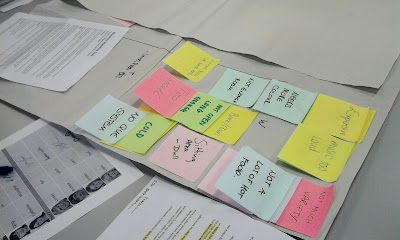This afternoon, my group within the branding and advertising module met up in Starbucks for coffee in order to revisit our marketing techniques for the product 'Pillowtalk'.
We identified 2 potential market segments:
- wives of those in the army
- business couples
As a group, we came to the conclusion that we should aim the product at 'business couples'. We arrived at this decision because we felt that £199 for the Pillowtalk product (2 speakers and 2 rings) would be more affordable to this particular target audience, rather than wives of those in the army. Business couples tend to be more stereotypically wealthy. I guess this is because they're generically more mature, successful and professional.
We also decided amongst ourselves that it would be best to target the early majority of the consumer population. We felt that targeting businesswomen between the ages of 26-40 would be ideal as we thought it would be more likely that women would influence their partner to purchase this product.
WHAT is the product all about?
Each person has a ring sensor they wear to bed at night, and a flat fabric panel which slots inside their pillowcase. The ring wirelessly communicates with the other person’s pillow; when one person goes to bed, their lover’s pillow begins to glow softly to indicate their presence. Placing your head on the pillow allows you to hear the real-time heartbeat of your loved one.
WHY purchase this product?
Reasons for purchasing this product can be divided up into rational/irrational decisions.
Rational:
Irrational:
WHAT is the product all about?
Each person has a ring sensor they wear to bed at night, and a flat fabric panel which slots inside their pillowcase. The ring wirelessly communicates with the other person’s pillow; when one person goes to bed, their lover’s pillow begins to glow softly to indicate their presence. Placing your head on the pillow allows you to hear the real-time heartbeat of your loved one.
WHY purchase this product?
Reasons for purchasing this product can be divided up into rational/irrational decisions.
Rational:
- connects two lovers, regardless of the distance between them
- the product is cheaper than purchasing an accumulation of long distance flights
Irrational:
- creates an intimate interaction between two lovers, regardless of the distance between them
- a romantic gesture towards your lover
- proof that you're serious about your lover
- an emotional and sentimental experience
in saying these things..
WHAT will this product do for you as the consumer?
''When purchasing this product, you will automatically have the ability to connect with your long distance lover every night before you sleep.''
ADVERTISING THE PRODUCT
In order to best inform our target audience of the product, we decided that featuring an advertisement within a broadsheet newspaper would be ideal. This way we would be able to target business couples of a certain wealth and maturity who are more likely to travel i.e. more likely to be away from their lover. We also thought that we could advertise the product as a pull out extra within business women magazines.
Our group had also discussed featuring an advertisement within travel/flight magazines, however we felt that informing our audience of the product whilst they had already started their journey away from their partner wouldn't be ideal. On the other hand, the target audience could be persuaded to purchase the product before leaving their partner on their next business trip!
A sketch of a potential advert:
The content of the advertisement is based on the rational and irrational decisions of buying the product. The couple are seen standing either side of a heart (signifying their love for one another). They are lovingly looking over at each other, realising that despite the distance between them, the fact that 'Pillowtalk' has been packed in the suitcase means that their romantic connection can still remain for the duration of the business trip.
The slogan could be either
- ''we're going to be okay, we've got Pillowtalk ''
- ''business trips made romantic, only with Pillowtalk '' (as seen on the advert sketched above)












